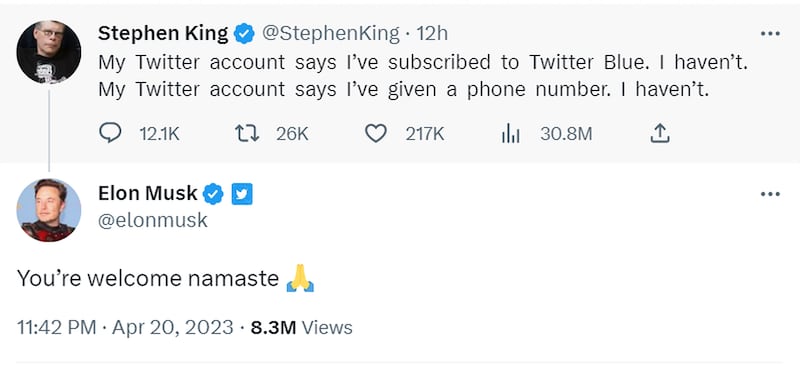Elon Musk’s ludicrous Twitter Blue fiasco continues to inflict further damage on the limping social network. But the clumsy plan to shift the site’s former identity verification system into a (so far failed) moneymaker open to anyone willing to pay a subscription fee, has at least done us all some service.
It’s provided insight into the complexities of offering confirmed online social media identities, and the parameters within which value is associated with verification. Initially this was, or at least seemed, straightforward. When Twitter introduced its blue tick verified accounts in 2009, the intent was to enable Twitter users to know that an account was who or what it professed to be.
This was increasingly important as tweets began to go mainstream, with Twitter used by politicians, public figures, businesses, media figures, activists and others. As journalists began to source quotes for stories from Twitter, it became perfectly acceptable to see “tweeted” alongside the name of a US president or a taoiseach. A verified identity – one marked by a blue circle with a tick mark inside – offered assurance.
However, verification was only granted to accounts that Twitter deemed deserving after a woefully non-transparent application process, predictably reshaping the blue tick into a badge of exclusivity and “internet clout”, as Vox puts it. Even though that wasn’t actually the point. And even though that’s an exasperatingly narrow, privileged view that forgets that the blue tick was an extremely important form of authentication (and therefore, safety) for global human rights defenders and activists, in places where few care about blue-ticked Kardashians.
READ MORE
But because exclusivity and clout were seen by so many as the point, they came to be the point.
Then, when Musk took over the platform, he decided blue ticks should be a selling point. And a relatively cheap one at that: for $8 a month, anyone could have one. But rather than offering “power to the people”, as he tweeted on his first day as CEO, Musk instead gutted the tick’s value.
Now the tick has little to no value. And not just because, in the initial launch, loads of bots and faked accounts easily got blue ticks (it appears that when you strip out employees and teams that understand online safety, things can go embarrassingly awry). Musk has erased the tick’s value in multiple other ways too.
Where it once indicated an established profile, now the tick only marks someone willing to give Musk $8. That’s a pretty low “internet clout” bar. Where the tick once signalled that you were reading tweets from a person or organisation with some kind of profile, reputation, veracity, position or expertise, and not just some randomer tweeting into the ether, it now regularly marks just some randomer tweeting into the ether.
And Musk has alienated many of the existing blue tick accounts that drove significant Twitter traffic, through general insults and his supposition that they would all become cash cows and pay his new subscription fee.

Last week, Musk’s deadline for paying up to retain the tick came and went and non-paying accounts, including those of well known figures like Stephen King and Ian McKellen, lost their ticks. Then, mysteriously, farcically, Twitter reinstated the ticks on their accounts and some others, even though they hadn’t paid.
Blue tick value plummeted as Musk’s hoped-for income stream became what many of Twitter’s highest profile accounts now didn’t want at all. Many protested at being reassigned a free blue tick, stressing they neither asked nor paid for it. Its value is now negative. All it verifies is a willingness to pay Musk for a Twitter Blue account. Or not.
Musk, if he were a different person, with something more productive than a gormless troll’s concept of the social media business, could have gone about this differently. A subscription service makes sense. So does an identity validation offering. On Twitter, they should have been decoupled.
There are even real world examples. Meta has a verified account badge programme for Facebook and Instagram based on Twitter’s original approach – the irony.
The past week has demonstrated that identity verification by tick or badge, or whatever chosen signifier, isn’t about privilege or internet clout. It’s about identity verification.
Musk’s individual actions on one platform have made it far easier to see the value of account verification in certain cases, and understand that it isn’t about, as the billionaire sometimes-world’s-richest-man Musk put it, “lords” and “peasants”. Formal social media platform verification for some organisations and individuals helps manage some of social media’s biggest problems, mis- and disinformation, and fraud.
Its value is that you and I can know certain accounts are who they say they are. Other value may then accrue, or fall away, but the basic value – and it is considerable – is just that. Given its scale, if Twitter cannot offer some meaningful verification structure for impactful accounts, it just becomes ever more meaning- and value-less. That’s a lesson for every social media platform.

















